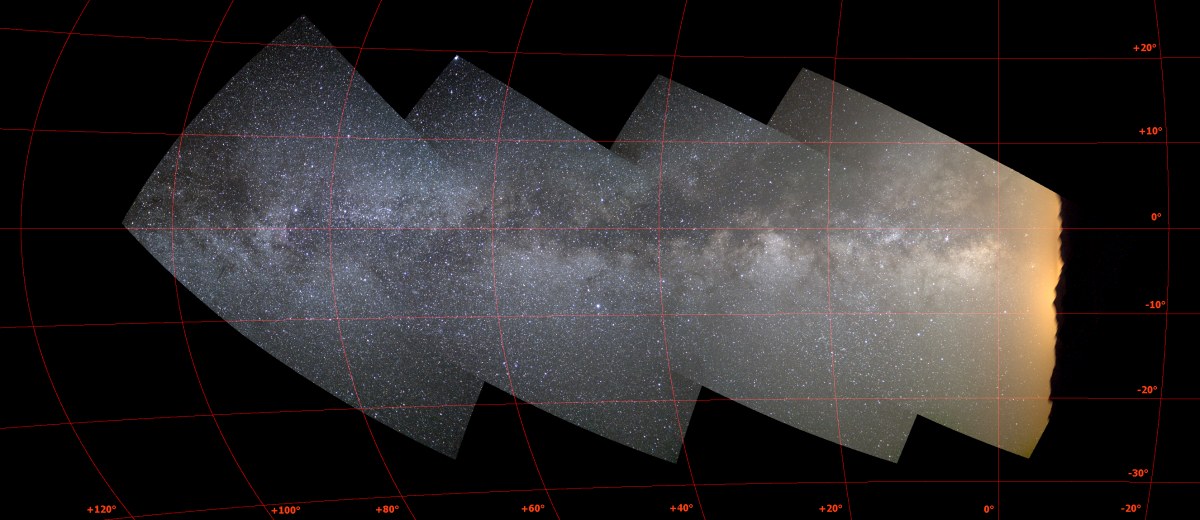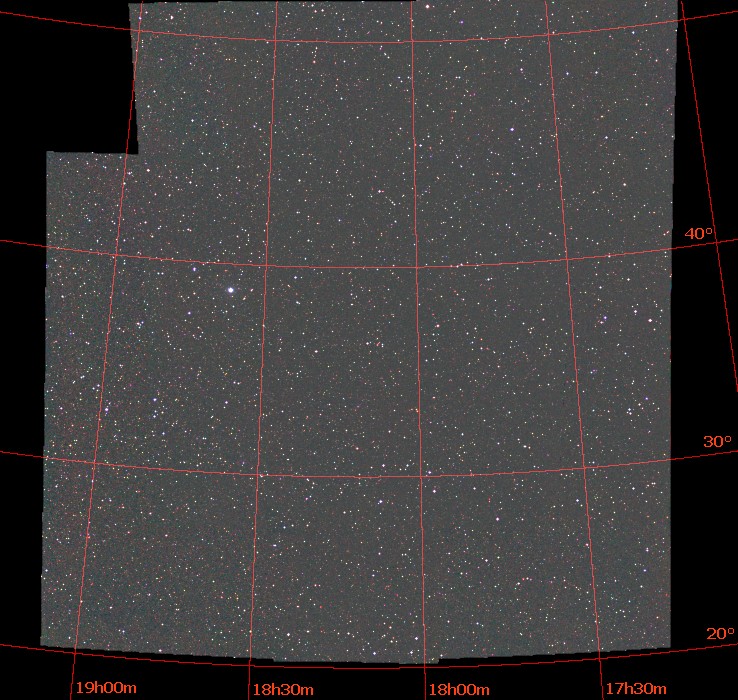
COMPLEMENTS
The coordinate system more used in astronomy is the equatorial system. But stellar cartographic tools of Iris also project images in the galactic system or the ecliptic system. The first possibility is useful for Milky-Way representations. Second possibility is more confidential. It will enable you to show solar system objects, the zodiacal light for example..
To display our panorama in the galactic system (release version 5.51) choose the corresponding option in Stellar cartography (the same option is available for the coordinates reticule drawing operations):

The principle for constructs a stellar projection is then identical to the equatorial system (but you have to enter longitude degrees, not ascension right hours):

Here the Valerie's panorama in the galactic reference system:
 Aitoff projection
using galactic system. The plane of Galaxy is marked by
Aitoff projection
using galactic system. The plane of Galaxy is marked by
the horizontal axis at latitude 0°. The intersection point
at longitude and latitude 0° define here the center of the Galaxy.
Click
on the image for display a enlarged view.
When the focal length of objective lens increases, it can be necessary to use a more dense star catalogue than the SKY2000. TYCHO-2 catalogue is an ideal companion for focal length from 50 to 500 mm. The catalog contain up to 2,5 million stars, until magnitude 12 approximately. Install the catalogue in a directory of your hard disk or a CD-Rom, and indicate the path to Iris:


TYCHO-2 catalog can be used in the same manner as the SKY2000. For example:

Area of the sky in the vicinity of the stars Gamma Lyrae
and Beta Lyrae.
Image taken with a Canon 350D (Baader IR-cut filter) and Canon
50 mm f/1.2 L lens stopped to f/2 (60 seconds exposure in urban condition).
The adopted
size of pixels is 6,25 microns.
With a focal length of 50 mm and with the TYCHO-2 the astrometric reduction allows to position stars at 5 arc seconds precision:

Part
of the F=50 mm lens image. M57 nebula (ring nebula) is near
the center.
It can be localised very precisely by it's equatorial
coordinates once the astrometric reduction is carried out.
Below, a conical projection of a mosaic of 4 frames carried out with the 50 mm lens (the adopted tangent declinaison of the cone is 35°, i.e. Theta=35°):

The 50 mm f/1.2 Canon lens offers sharp images, but suffers from slight lateral chromatism. The effect is of course accentuated in the corners of the image:

50
mm f/1.2 @ f/2 images (corner).
The laterl chromatism appears like a small spectrum associated with
each star.
The distortion estimation and correction tools can be used for each of three the colors planes. First, isolate the 3 layers color channel on distincts files (red, green and bleu) - see Digital photo menu:

By using TYCHO-2 compute three sets of coefficients of distortion. For the example one finds:
Red channel:
A5 = -9,4979 10-17
A3 = 2.7011. 10-9
A1 = 0.99014
Green channel:
A5 = -6.8540. 10-17
A3 = 2.6264. 10-9
A1 = 0.99077
Blue channel:
A5 = -9.3455. 10-17
A3 = 2.6665. 10 -9
A1 = 0.99112
The geometrical correction of the distortion is then carried out for the three layers, then the image color is rebuilt:
>TR R G B
Here the comparison, before and after reduction of the lateral chromatism:
|
|
|
Note: you can plan to reduce the lateral chromatism of a
color image
without carrying out astrometrical reduction by considering
that the refrence image of is the green component (for example). Than, the
differential distortion of bleu and red channel is corrected relative to the
green channel.